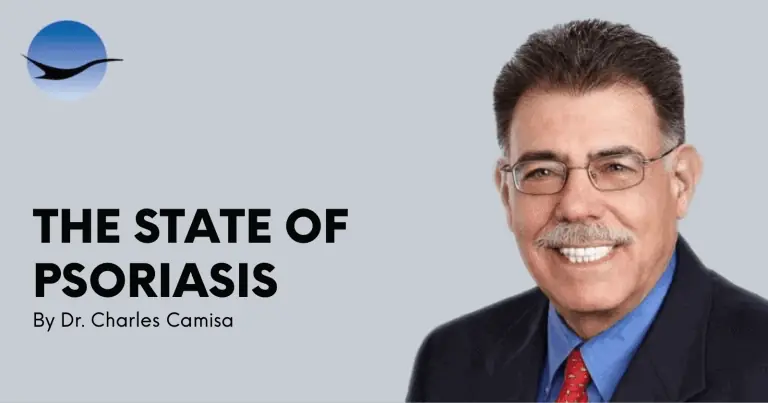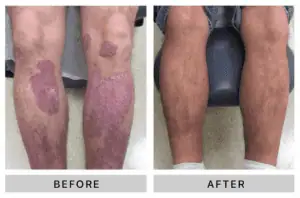The State of Psoriasis

Having investigated and treated Psoriasis for over 40 years now, I am writing this article to honor the millions of patients and their families who have been affected by the disease. Psoriasis is common, affecting 2.5% of the US population, estimated at over 8 million people. Psoriasis does not discriminate: it affects all races, men, women and children.
Psoriasis is not only skin-deep. Psoriasis was initially thought to be just a skin disease with rapidly dividing cells that accumulated on the surface. After decades of laboratory research using blood and skin samples donated by patients, we now know that psoriasis is a type of autoimmune disease which affects skin, joints, and almost every other organ system caused by self-made natural inflammatory substances.
In the remainder of this article, I will include questions from patients on my blog which I have updated to shed some light on some of the latest developments in psoriasis research:
Where are the most common areas to get psoriasis?
Psoriasis seems to be induced or aggravated by trauma. Thus, the most commonly involved areas are the scalp (often first to appear), elbows and knees, tailbone area, and genitalia.
Is psoriasis genetic? No one in my family has it.
Psoriasis is considered a genetic disease because many different genes have been discovered in family members that are associated with psoriasis. The gene or genes are only one part of the story, however. There also has to be trigger from the environment.
What are some of the triggers for psoriasis?
The trigger that is most well known is infection, particularly with the Streptococcus bacteria. In people who don’t have the genetics for psoriasis, the skin disease may go away after the infection, but in those who do, it may progress into chronic psoriasis.
Other triggers include severe stress, cold and dry climates, smoking, and some drugs such as beta-blockers, lithium, hydroxychloroquine, and interferon. Prednisone is more likely an aggravator of existing psoriasis rather than a trigger of new psoriasis.
What is Psoriatic Arthritis?
Psoriatic arthritis is an inflammatory arthritis that is caused by the same genes and circulating chemicals that cause the skin disease. It may affect up to 30% of patients with skin psoriasis. There are a few types of arthritis, but the most common one affects the small joints of the hands and feet and causes morning stiffness and swelling, very similar to rheumatoid arthritis.
Can children get psoriasis? Most of the people I know with psoriasis are adults.
Absolutely yes! Psoriasis is often considered an adult disease because the average age of onset is about 30 years. Here are some surprising statistics: 30% of all new cases of psoriasis start before age 15, 10% before 10 years, and 2% before 2 years. Babies can even be born with psoriasis! The incidence of psoriasis is estimated to be 3 new cases per year per 1000 children.
Besides the skin and joints, what other organ systems are affected by psoriasis?
The most important association is the “metabolic syndrome” which includes obesity, type 2 diabetes, hypertension, high cholesterol, and coronary artery disease. All of these features can be improved or prevented with weight loss, exercise, and medical management. Other less commonly affected organs may include the liver and the eyes.
How is psoriasis treated?
There are now many different ways of treating psoriasis. When I first started treating psoriasis, we only had steroid creams, coal tar, and ultraviolet light called phototherapy. We actually admitted the more severe cases to hospital for 2-4 weeks and treated daily with these modalities.
They cleared up and stayed clear for about 3 months. Then it all gradually came back, and we started over again. We still use outpatient phototherapy without the tar for psoriasis and continue maintenance to prevent flare ups.
Please tell me about some of the newer internal treatments for psoriasis.
For the last 15 years there has been an explosion of new drugs for psoriasis that have been developed to block some specific chemicals that are increased in patients and which cause inflammation in the skin and joints. The inflammation then promotes the rapid overgrowth of skin cells and damages the joints.
Most of these drugs are synthesized in the laboratory. They are injectable proteins called Biologics that block tumor necrosis factor and various interleukins. Most of these can be injected by the patient at home or at the office by us if you prefer. Some familiar names are Enbrel, Humira, Stelara, and Taltz. There are at least 8 others approved and more in development.
We use all of these drugs in the Psoriasis Treatment Center at Riverchase Dermatology.
Does psoriasis affect the nails?
Yes. As psoriasis affects the skin under the nail (nailbed) and the skin around the nail (nailfolds), it causes changes in the growth rate, color, attachment, and the surface such as ridges and pitting.
How is nail psoriasis treated?
Psoriasis of the nails is very difficult to treat. Ultraviolet or laser light helps the psoriasis around the nail but can’t penetrate into the nailbed. Topical creams and solutions also can improve the appearance of the nail. The treatments that work best for the nail are the Biologic injections discussed above or pills such as Otezla or Methotrexate which are taken internally.
I have some pain in my fingers. How do I know if I have Psoriatic Arthritis?
If your pain, swelling, and stiffness is mainly in the morning, and takes 15 minutes to an hour to loosen up, that may be a sign of psoriatic arthritis. If you have one finger that’s swollen like a sausage, that is called dactylitis which is also a strong sign. Psoriatic arthritis may also affect tendons. If you have swelling or tenderness of the Achilles tendon at the heel, that may be a sign. Nail pitting and psoriasis on the same finger with joint pain may also indicate psoriatic arthritis.
Psoriatic arthritis may be difficult to diagnose. If you have psoriasis, there is about a 1 in 3 chance that you would develop psoriatic arthritis during your lifetime, but it can be confused with or overlap with rheumatoid arthritis or osteoarthritis. For this reason, we may order blood tests, X-rays, of a consultation with a Rheumatologist.
How is Psoriatic Arthritis treated?
Some of the drugs mentioned earlier are FDA-approved, meaning safe and effective, for psoriatic arthritis. Thus, if you have both psoriasis and psoriatic arthritis, you may improve if treated with Enbrel, Humira, Cimzia, Stelara, Tremfya, Taltz, Cosentyx, or Otezla. Methotrexate is often used in combination with these medicines. Xeljanz is only approved for psoriatic arthritis.
I understand that Biologic drugs are immunosuppressive. Should I stop them during the Covid-19 pandemic?
The Biologics are targeted to specific components of the immune system that lead to inflammation of psoriasis skin and joints. Although necessary for normal immunity, these components are found in excess in psoriasis patients. They are not blocked completely by the drugs.
Therefore, the National Psoriasis Foundation has recommended continuing the Biologic that has been prescribed for you because of the risk of recurrence of the psoriasis and arthritis, while still following all of the well-known CDC recommendations for prevention of Covid-19 infection. Moreover, when a Biologic is stopped for a while, there is a possibility that some its effectiveness will be reduced.
What can I expect for the future?
Even though we have so many new drugs for psoriasis, there is still no cure. Treatments need to be continued long-term to maintain clearance of the skin and remission of the arthritis. There are many new drugs under development that work by novel mechanisms as biologic injections, pills, and creams. Be on the lookout for these in the next few years.
Charles Camisa, MD, FAAD
Director, Psoriasis Treatment Center and Phototherapy Department
Recommended Reading:
Handbook of Psoriasis, 2nd Edition, 2005, Blackwell Publishing, by C. Camisa



